A tale of two turfs
 Elsewhere in the world, grass is a forgotten surface for tennis, but it survives here still amid clarion calls for courts that deliver a more consistent, reliable, arguably slower, game as baseline strategy dominates modern thinking
Elsewhere in the world, grass is a forgotten surface for tennis, but it survives here still amid clarion calls for courts that deliver a more consistent, reliable, arguably slower, game as baseline strategy dominates modern thinking
Lawn tennis is a byword for the English game and Wimbledon is still the must-have Grand Slam title for the world's players.
Yet, grass courts are disappearing fast from the UK's tennis landscape, with many believing that they're either too expensive to run, under used or, simply, that a club is better served by replacing them with synthetic surfaces.
And that's before the pressure from players for consistency of bounce and playability comes into force.
The parlous state of some grass courts, particularly in parks, is echoed in British tennis. A catalogue of under-performance in the David Cup, culminating in us recording one of our lowliest world rankings in recent times.
Davis Cup captain, John Lloyd, has taken the hit - losing his job - while brother David has hit out recently against the game's governing body - the Lawn Tennis Association (LTA) - accusing it of failing to generate a player of truly world standing since Fred Perry, who won Wimbledon in 1936.
The sobering fact, too, is that the likes of Andy Murray and Tim Henman achieved world status largely without the aid of the LTA system, into which millions of pounds are poured annually.
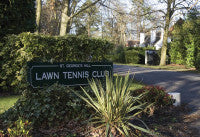 Elsewhere in the world, grass is a forgotten surface for tennis, but it survives here still amid clarion calls for courts that deliver a more consistent, reliable, arguably slower, game as baseline strategy dominates modern thinking.
Elsewhere in the world, grass is a forgotten surface for tennis, but it survives here still amid clarion calls for courts that deliver a more consistent, reliable, arguably slower, game as baseline strategy dominates modern thinking.
A stronger emphasis on youth development in tennis clubs might revive our fortunes, particularly if all-weather training facilities are available - indoors and out.
The number of grass courts continues to decline and some LTA clubs are reportedly under pressure to turn more of them into ones that are playable on throughout the year. Figures on LTA affiliated sites suggest that as few as one in ten courts are grass.
The issue of high maintenance is seemingly always going to weigh against grass, but some clubs believe the case for 'the real thing' remains strong, if all factors are considered, and are resisting the march towards other surfaces.
Surrey is one county that can claim its fair share of grass courts, and probably one of the finest sites is St George's Hill Lawn Tennis club near Weybridge, which has been defying the critics ever since opening its doors in 1913, albeit with some concessions.
After driving through the guarded, gated entrance to St George's Hill estate, lined with tall trees and imposing mansions set in mature landscaping, I gain an early impression of what to expect on arrival at the club, which opened nearly a century ago exclusively for use by estate residents.
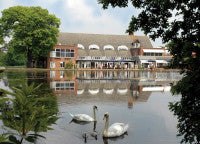 'The Hill', as its known by locals, was once barren heathland partly owned by Royalty, bought in 1900 by London businessman William George Tarrant, whose vision was to develop an exclusive estate for well-heeled city business people, with a tennis club established at its heart, to offer a leisure provision - only later becoming a private members club when Tarrant hit financial difficulty while undertaking the construction of the Wentworth estate.
'The Hill', as its known by locals, was once barren heathland partly owned by Royalty, bought in 1900 by London businessman William George Tarrant, whose vision was to develop an exclusive estate for well-heeled city business people, with a tennis club established at its heart, to offer a leisure provision - only later becoming a private members club when Tarrant hit financial difficulty while undertaking the construction of the Wentworth estate.
The ribbon was cut by Prince Alexander of Teck, brother of Queen Mary, and ever since then the celebrity profile of the club has shone brightly - past and present alumni numbering top Premiership footballers, golfers, pop and rock stars and media moguls.
It's proven to be a hot spot for advertising shoots over the years - tennis greats Bjorn Borg in a Robinson's commercial and Pete Sampras filming a Nike video - to featuring in the 'Town on Trial' 1960s movie.
The club originally catered for all lawn sports, including bowls and croquet, but, while those days have gone, the drive to deliver an all-embracing sporting hub to serve St George's 3000-strong membership has seen new era additions that include fifteen synthetic tennis courts, four squash courts, gym, swimming pool, day spa, sauna, two indoor courts, badminton courts, table tennis courts, bridge, treatment rooms and a fitness studio.
The jewel in the crown remains however - the 15 grass courts - as many as any private club in the country can boast.
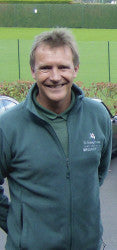 The first weekend in May marks the official start of the grass court season, which runs through to mid September - the signal for a stampede from winter to summer surfaces. "Despite only being open for half the year, our grass courts enjoy as much, if not more, use as the synthetic courts over the year in total," states head groundsman, Paul Bishop.
The first weekend in May marks the official start of the grass court season, which runs through to mid September - the signal for a stampede from winter to summer surfaces. "Despite only being open for half the year, our grass courts enjoy as much, if not more, use as the synthetic courts over the year in total," states head groundsman, Paul Bishop.
An advocate of the grass game, and a man with decades of experience (including 27 years at St George's Hill) preparing and nurturing tennis courts, Paul is passionate in his belief that grass can, and must, continue to play a strong role in UK tennis.
"The numbers of grass courts have dropped quite substantially over the last twenty years through either cost or convenience reasons," he explains. "Yet, there is really no reason why this should be the case. They are no harder to look after and, cost wise, there is actually only a marginal difference if all the replacements and man-hours involved in cleaning the artificial surfaces are taken into consideration. Most importantly though, grass courts are nearly always more popular with members."
A self-confessed tennis enthusiast, Paul traces his love for the game back to when he first joined the club in the early 1980s. He began his career as a greenkeeper in the late 1970s, training at Fox Hills Golf Club where he spent four years in his first job straight from school. A brief stint in landscape gardening followed, before Paul realised the way forward was elsewhere.
St George's Hill first appeared in the frame following an advertisement Paul spotted for a greenkeeping post. After applying "for the interview experience alone, not expecting to get the job", he was offered the position, and it was from then that his love affair with greenkeeping and tennis blossomed.
His early St George's Hill career he spent working under Mike Thorne, whose father, Jim Thorne, had just left to become Head Groundsman at the All England Lawn Tennis Club, Wimbledon - a man Paul credits as the single biggest influence on his professional development, having helped him out at key stages in his career.
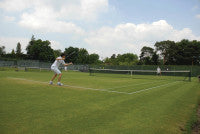 After working with Thorne for five years, Paul applied for the head groundsman's post at Surbiton Lawn Tennis and Squash Rackets Club, encouraged by his boss. Once again, only enquiring about the job for the experience of the interview, he was asked back for a second interview and was offered the job, only later finding out that Thorne had proved instrumental in his success by recommending Paul as the ideal man for the job to a member of the Wimbledon club, who was also a member at Surbiton at the time.
After working with Thorne for five years, Paul applied for the head groundsman's post at Surbiton Lawn Tennis and Squash Rackets Club, encouraged by his boss. Once again, only enquiring about the job for the experience of the interview, he was asked back for a second interview and was offered the job, only later finding out that Thorne had proved instrumental in his success by recommending Paul as the ideal man for the job to a member of the Wimbledon club, who was also a member at Surbiton at the time.
In August 1988, the head groundsman's post beckoned at St George's Hill after Mike Thorne's departure. "I assumed that, because I loved the place so much and this was the perfect job for me, that I would have no chance of getting it," Paul confesses "but, when the interview came, far from feeling under pressure, I ended up just having a chat with people I knew from old, including Jim."
"I found out later that evening that I was offered the job. A few of the board were in favour of one of the other guys but, because Jim was present, he convinced them of my suitability for the post - which proves the old saying that it's not what, but who you know that counts."
 The prime driver behind the decline in the number of grass courts throughout England is said to be the vastly greater amount of time, effort and cost involved in keeping them in good playing condition, yet Paul believes this is not the case.
The prime driver behind the decline in the number of grass courts throughout England is said to be the vastly greater amount of time, effort and cost involved in keeping them in good playing condition, yet Paul believes this is not the case.
In the grass season, a typical day for the St George's Hill team dawns at 6.30am, with Monday, Wednesday and Friday allocated to prepare the grass courts by way of a simple regime of dressing and mowing.
"We conduct most of this work with a John Deere 22" walk behind", he reveals, preferring this to other machine makes at the club. "It's my first choice every time," he says with unstinting praise. "We've built up a strong relationship with the company and, if we could afford to, we'd spend all our machinery budget on their machines."
Paul has good reasons to keep the grass courts at their best, not only for the pleasure of members but to provide the perfect setting for the tournaments it stages each year.
The International Lawn Tennis Club of Great Britain play there annually, and St George's Hill's own open tournament is played out in the first week in August. "It regularly drew Wimbledon players and still attracts celebrity regulars, as well as some of our 1,500 or so tennis-playing members," Paul adds.
Given the numbers that gravitate to grass in summer, Paul and his team of four have to ensure that each of the courts remains in top form right through the season, a task that comes with challenges.
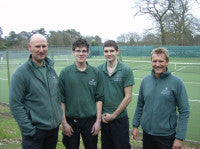 Working alongside Paul is assistant head groundsman Andy Dawe, who also hails from Fox Hills, and is now in his fifteenth year at St George's Hill. There's Chris James too - in the team for two and a half years now and someone whom Paul is determined to hold on to, while last, but not least, son Drew, who, like his father, has entered the profession after leaving school and completing successful summer posts at the club.
Working alongside Paul is assistant head groundsman Andy Dawe, who also hails from Fox Hills, and is now in his fifteenth year at St George's Hill. There's Chris James too - in the team for two and a half years now and someone whom Paul is determined to hold on to, while last, but not least, son Drew, who, like his father, has entered the profession after leaving school and completing successful summer posts at the club.
The key issue with grass courts is achieving the correct bounce and evenness of surface, Paul explains, as is developing the right soil, with the correct moisture levels. Knowing when and when not to roll "can make or break" a court, he believes.
"We usually roll and pre-seed around April time, but the moisture levels have to be just right, so this can often vary year on year depending on rainfall," he states. "If there's too much moisture, the soil will compact, whereas, if it's too dry, you'll break the roots of the grass by rolling. So, we are always treading a fine line, although experience will usually lead you in the right direction."
Trying to educate the committee "can sometimes be difficult", Paul admits, especially when Wimbledon standard surfaces are often those that any self-respecting lawn tennis club will aspire to achieve.
"My bosses are very good to me but they sometimes are tempted to look too closely at what the All England Club do, forgetting that we're in a different position with different factors to take into account. If they see Wimbledon rolling all the time, they think we should be doing it as well, which isn't always the case."
That said, Paul assists at Wimbledon during the fortnight, an experience that has taught him some valuable lessons, as well as a few ideas borrowed from Thorne during his tenure there and the Wimbledon groundscare team.
 Most notable perhaps are the ball bounce tests. "This is a great one for achieving the optimum ball bounce for your courts and to help gauge how much thatch needs to be taken out of the playing surface."
Most notable perhaps are the ball bounce tests. "This is a great one for achieving the optimum ball bounce for your courts and to help gauge how much thatch needs to be taken out of the playing surface."
The test is performed by dropping a ball from a height of 100cm onto a concrete surface, then repeating the procedure on grass, with the aim of achieve 80% of the bounce on the hard surface.
Due to the tiered nature of the club's grass courts, Paul has found it hard to attain the degree of uniform bounce that Wimbledon boasts, yet he has seen "a vast improvement" in recent years, thanks to the programme of koroing and frequent overseeding.
With a low rootzone in certain areas of play, problems can arise with an unevenness of drying, he says. "Some courts stay wetter for longer while others dry out quicker. The site is also built on a clay foundation which can, in some places, lie close to the surface, as little as four inches and eight at most. You need to know the workings of each court individually to be able to manage it properly," insists Paul.
Since investing in koroing in 2004, the courts have seen a dramatic reduction in the quantity of thatch, resulting in cut heights increasing from 8mm two years ago to 10mm as standard now because ball bounce became too high - the koroing taking off an extra inch of playing surface.
"Although good ball bounce is a sought-after attribute for a grass tennis court, you're never going to please everyone," Paul says. "Some players preferred the high bounce, others didn't. You just have to go with what you think is best, and now I feel we have achieved a happy medium."
The Graden that Paul applies to the court annually has further reduced thatch build-up. "The several years of applying this maintenance regime to the courts have brought them up to an excellent standard," he says.
Sound maintenance is the bedrock of success, he continues, and helps ensure koroing is effective. Regular overseeding plays its part. "I use at least three 25kg bags per 1,500 sq yards over two courts and use a ryegrass mix."
The seed sector is thriving and is in the throes of huge innovation as a wealth of new cultivars come to market, in some cases dramatically improving germination, turf growth and thickness of sward. Paul adds, "Maintaining grass courts has never been simpler for us thanks to the huge improvements in seed quality, which was brought to our attention."
 One other product, tried and tested with great success at St George's Hill, is PrimoMaxx growth regulator. "I heard about it some three years ago and, after initially having reservations about its quality, I can report that it has made a vast difference to the thickness and quality of the turf."
One other product, tried and tested with great success at St George's Hill, is PrimoMaxx growth regulator. "I heard about it some three years ago and, after initially having reservations about its quality, I can report that it has made a vast difference to the thickness and quality of the turf."
"We usually apply it just before April, adding small amounts on a monthly basis through to September. The applications have to be well planned for the best results though."
Although the warmer months are taken up largely with tending the grass courts, the rest of the year proves no less taxing, as the fifteen synthetic turf courts come more into play.
"Contrary to popular belief, artificial courts take just as much looking after as grass does," states Paul categorically. "There's more work and preparation involved with artificial surfaces than people think. Since I've been here, we've had to replace the courts at least every ten years."
The lifetime of synthetic turf, no matter what type and mix of material, will usually not exceed ten years if they receive a high volume of use, Paul argues, "and, with the cost of replacing four courts amounting to anywhere between £60,000 - £70,000, maintenance figures can soon rise dramatically.
"The cost of real versus synthetic come about even when all the replacements and cleaning are accounted for," says Paul. "Remember that we have to blow and power brush the artificial courts daily, as they gather a lot of debris and build-up with heavy use and depending on the seasons."
Just as choice of seed is a critical factor in grass court performance, selecting the most appropriate synthetic turf is key, as different specifications will suit different climates and applications, Paul maintains.
St George's Hill has chosen three different makes since Paul made his first switch in the mid-1980s. Savannah turf was used for ten years before being replaced in the mid-1990s by Olympus. Tiger Turf is the most recent replacement, in 2009 but "the jury's still out" on his latest acquisition, says Paul. "The old rubber granules used on the Olympus turf meant power brushing wasn't an option, and the presence of the rubber crumb also meant we couldn't topdress with sand. Although we still have seven of these courts, I'm pleased that we're now moving away from it as maintenance was often tricky.
"The benefit of real turf is that, by and large, you know what you're dealing with whereas, with artificial, the different brands can vary so much, so it can be a case of expensive trial and error."
While the members and committee have stuck fast in their desire to keep all the grass courts, moves are afoot to offer a spectrum of synthetic surfaces. Current thinking is to add three artificial clay courts to the St George's Hill portfolio.
The mindset remains the same on the real stuff though. "I don't see us getting rid of any grass courts but, if we can offer our members all the options, I believe the club is all the better for doing so. We already have a mix of artificial; eight floodlit courts and the grass, so clay would add a new dimension."
In the Surrey real turf belt, success for St George's Hill lies in its belief that choice for members is paramount. A tennis focus where the traditional rubs shoulders comfortably with the cutting edge.
